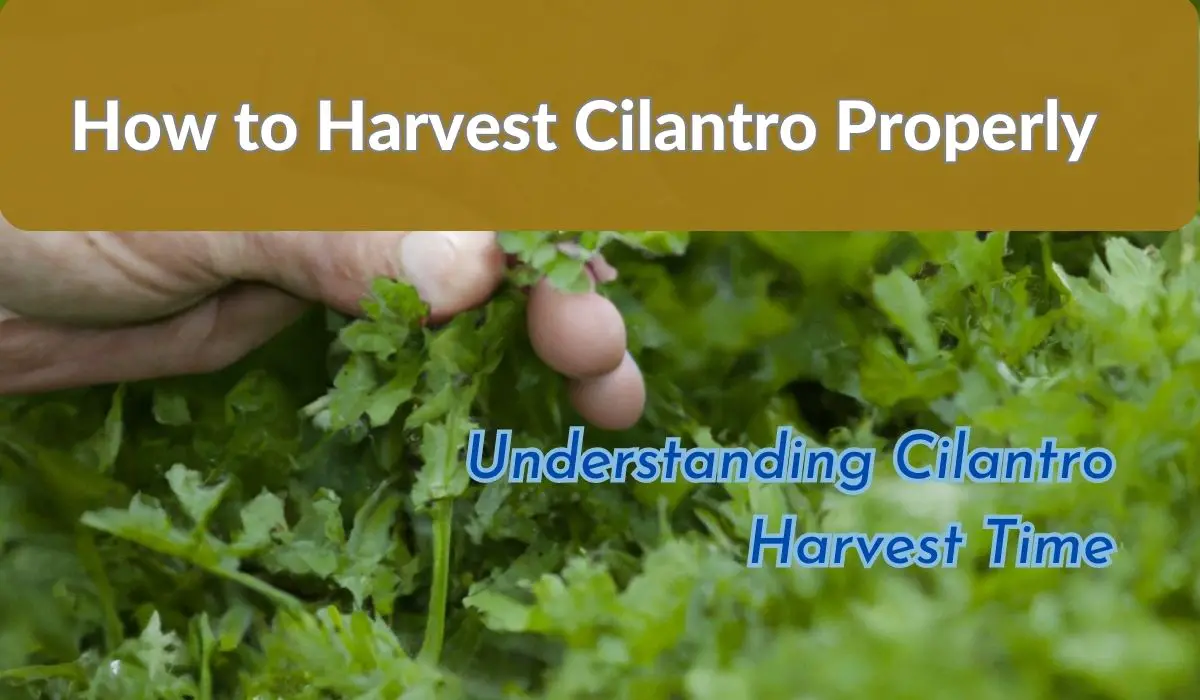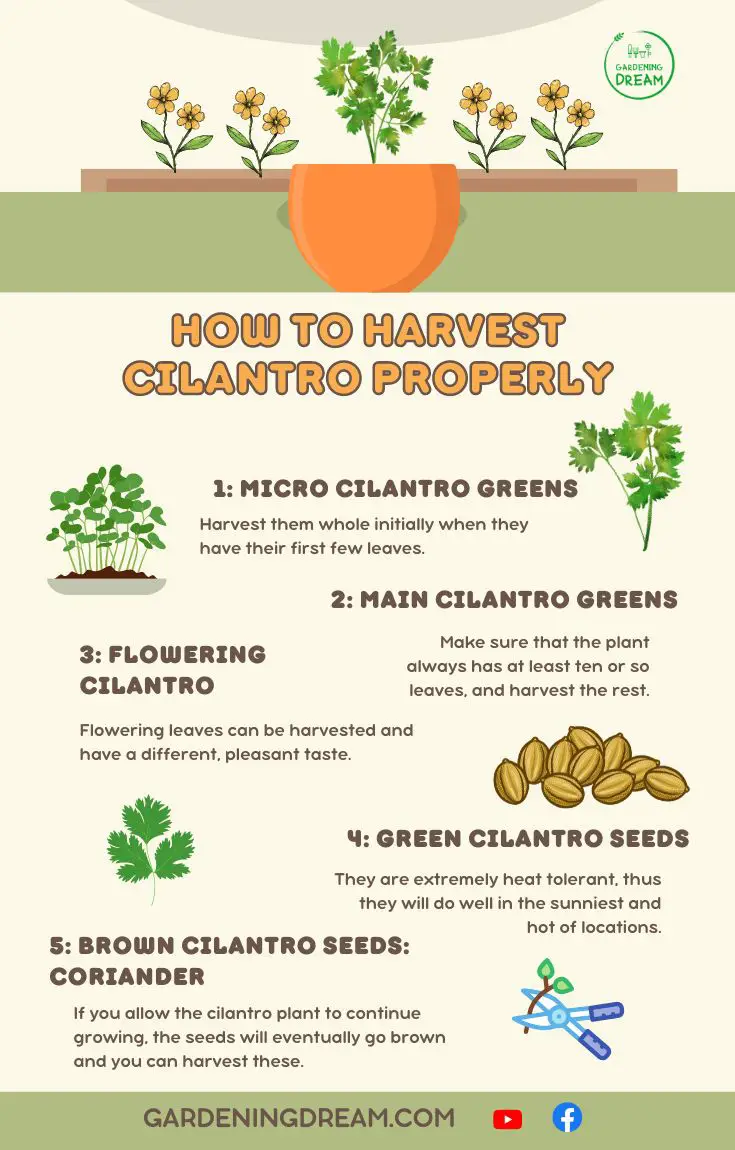Last Updated on April 21, 2023 by Griselda M.
Let’s have a look at how to harvest cilantro without killing the plant. This delicious herb is a very useful, healthy plant to grow, and, cultivated correctly can allow you to produce a nearly year-round supply for salads, stir-fries, curries, dhal, gin and tonic, and even herbal teas.
Quick Summary: How to Harvest Cilantro Leaves
Harvesting Cilantro is easy to pick leaves off individually or choose small stalks to trim with scissors for fresh use. When the cilantro grows its stalk, cut off the plant after the seeds drop and let it self-seed. Harvest coriander seeds and use them to grow future crops and as a spice.
A Quick Overview of Cilantro: Understanding Cilantro Harvest Times
The herb Cilantro refers to the fresh or dried leaves of Coriandrum sativum. If you allow the cilantro plant to go to seed, it produces coriander, which is interestingly a spice. Very few plants are both herbs and spices. Many people find the herb Cilantro unpleasant due to a genetic factor that causes the plant to taste like boiled bugs in soap to them. These unfortunate folks can however normally eat the coriander spice.
The plant grows rapidly from seed, and produces bigger and bigger leaves until it has enough energy to produce a flower stalk – when this happens, the leaves change shape and it becomes very frilly and develops whitish purple-pink flowers depending on the genetics of your plant. Once it has successfully produced seeds in your garden, you basically have cilantro as a weed – forever!!
Cilantro and rocket are those herbs that you grow once and have forever. They just seed and come up in the funniest places. I have had cilantro growing on my roof, in the hubcap of my car, in a branch of a tree – this stuff gets everywhere.
Read more about Cilantro here.
When to Plant Cilantro
All the time.
Cilantro is not a long-lived plant, so succession planting is important. In hot months where temperatures exceed 80-85°F, it needs to be planted in shady cooler parts of the garden, as long as it gets some dappled sunlight and maybe early morning sunlight it will thrive. It is not fond of direct sunlight in summer and will go to seed fast.
In autumn and spring, it can be planted in full sunlight and will thrive. If you only get one or two frosts a year, you can grow it outdoors in winter, for the rest of us, it is a windowsill or greenhouse crop for winter. In colder months grow it in pots on a sunny windowsill.
How to Plant Cilantro
1. Acquire some seeds – get them from a fellow gardener or buy them online. If you buy coriander seeds just check that they have not been irradiated. Irradiated seeds will not germinate.
The Spice Way Coriander Seeds 5 oz, Star Anise 3 oz and Anise Seeds 4 oz
2. Use loose fluffy soil – if you are growing cilantro in a pot, use rich soil. If you are growing in your garden, dig the natural soil over, add compost, and if you can get some aged manure to add that, and dig it into this soil to a depth of 5-6″.
I believe in planting cilantro heavily. If you have collected seeds from plants you grew you can afford to do this. If you bought herb spice coriander seeds you can do this too. I put probably two to three seeds per square inch and then just rub my hands over the surface and this sort of digs them into the soil a bit.
If you have expensive seeds make little dents every three to four inches apart and put a seed into the hole. Cilantro thrives on being a bit crowded when young. You can thin them out later – this is one of the easiest ways how to harvest cilantro.
3. Water the seeds every day with a watering can and they will come up soon and form a thick layer of green delicious young seedlings. The advantage of planting heavily is that you can start harvesting them as soon as they form their first two leaves after the cotyledons. These first leaves have an exquisite flavor as do all microgreens. You can keep thinning them out until you have your best plants separated about 5″ apart. Now you can let these grow into bigger plants and this is where we need to discuss how to harvest cilantro properly without killing the plant.
You can grow cilantro with companion plants, learn more about the best companion plants for cilantro here.
When & How to Harvest Cilantro Properly
Learning when and how to harvest cilantro is quite easy if you plant the seeds densely! In the first few weeks, you will be thinning the plants out. When looking at how to harvest cilantro when thinning them out, you actually snip the little seedlings off at their roots – and you do this in such a way that the entire plant is removed and killed. You are actually harvesting cilantro so that you kill it. This allows you to make space for your chosen healthiest plants.
As you thin the plants out, the bigger plants will become more and more dominant. They will have a ring shape of leaves. When considering how to harvest cilantro at this stage bear in mind that you can harvest the leaves on the outside of the plant, leaving the fresh growth shoots to get bigger
Now and then, when you have a plant that reaches the 20-25 leaf stage, it will look almost like a bunch of celery. These plants, if they need to be thinned out further, can be harvested whole – pull them out gently and snip the roots off (this stops you from bringing other plants with them when you pull them up).
For fish dishes, there is nothing better than a big bunch of fresh cilantro like this. You can just cut it up as is, and the stems, juicy leaves, and delicious flavor are amazing. Harvest the herb five minutes before you use it, and try to get it to the table as fast as possible.
The active terpenes in cilantro evaporate rapidly. I always try to make cilantro dishes on the weekend and aim to have the plant out of the ground and into the dish and onto the table in under half an hour. This ensures maximum taste and benefit. When you have guests around they will comment and notice this. Much like a fresh tomato, corn cob, or carrot – something in cilantro changes after harvest, and within an hour of harvest you have a less magical version of the herb.
If you are just harvesting a few leaves from a cilantro plant, you can take older leaves for a strong flavor and younger leaves for a light flavor. I take a small pair of orchid snippers with me when I harvest herbs. Cut individual leaves carefully from your cilantro plant.

The good news is that it is really difficult to kill a cilantro plant by overharvesting. I have never succeeded in doing this as far as I am aware. If you harvest it heavily, it just gets a bit stunted and bonsai-like.
After you harvest your cilantro plant, store it properly, some tips here.
When is Cilantro Ready to Harvest?
Micro cilantro greens
As we have detailed above, if you plant it heavily, you will need to harvest plants whole initially when they have their first few leaves. This allows you to thin your plants out until you have your chosen plants that you will allow to get bigger.
Main cilantro greens
Once the plants are standing at least 8 inches tall, you will get a few weeks or months of being able to harvest outer leaves from the plants. Try to make sure that the plant always has at least ten or so leaves, and harvest the rest. At some point, the plant will bolt. I find that at this point the flavor changes as the leaves change in shape and the plant begins to invest in its flower stalk.
Flowering cilantro greens and pinks and whites and purples
The flowering cilantro leaves can be harvested and have a different, pleasant taste. I actually also use the young purple/white/pink flowers and salads for cooking – these also have a lovely flavor.
Green cilantro seeds
When the flowers are pollinated, they start to form little green cilantro seeds – for me, this is the highlight of the cycle. These little green bubbles of joy have the magic of cilantro and coriander all in one! I take these and make them into a paste, add a bit of vinegar, and keep them in my fridge in a little bottle. They last about 3-5 months like this and are a lovely paste to add to most things that you cook! If you would have added coriander add this. If you would have added cilantro, add this.
The green cilantro seed paste makes an amazing backup for those few months a year when you do not have cilantro growing.
Brown cilantro seeds: Coriander
If you allow the cilantro plant to continue growing the seeds will eventually go brown, and you can harvest these. At this point, I normally snip the plants off at the soil level and bring them inside – in a big basin. Hang them over the basin for a week or two until the stems are bone dry and then you can pull slowly over the bunches of seeds and they will fall into the basin below. There will be little sticks and things that fall too. You can separate these by placing the seeds in a basin and shaking it – the sticks float to the top as they are lighter and can be removed. These make great fire lighter.
In Summary: How to Harvest Cilantro Leaves
Harvesting Cilantro is easy to pick leaves off individually or choose small stalks to trim with scissors for fresh use. When the cilantro grows its stalk, cut off the plant after the seeds drop and let it self-seed. Harvest coriander seeds and use them to grow future crops and as a spice. You can also harvest green coriander seeds and make a cilantro/coriander-like paste. Do not stress too much when harvesting cilantro – the plants are really difficult to kill. Short of cutting the plant off at the roots, you can do very little else that can actually kill the plant.
Dr. Garth A. Cambray is a Canadian/South African entrepreneur and beekeeper with 28 years of experience in apiculture and specializes in adding value to honey. His Ph.D. research developed a new advanced continuous fermentation method for making mead that has resulted in a number of companies globally being able to access markets for mead. His company, Makana Meadery, exports honey mead to the USA where it is available to discerning connoisseurs. He has also developed technologies to commercially manufacture organic honey vinegar in Zambia for export globally. He holds a few patents globally in the ethanol industry and believes in technology and knowledge transfer for human development and environmental sustainability. One of his proudest achievements is the fact that the wind farm he started at one of his old apiary sites has essentially made his hometown carbon neutral.




